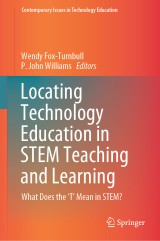Details
Locating Technology Education in STEM Teaching and Learning
What Does the ‘T' Mean in STEM?Contemporary Issues in Technology Education
|
160,49 € |
|
| Verlag: | Springer |
| Format: | |
| Veröffentl.: | 23.05.2024 |
| ISBN/EAN: | 9789819719952 |
| Sprache: | englisch |
Dieses eBook enthält ein Wasserzeichen.
Beschreibungen
This book offers clarity and consistency of thinking in relation to Technology Education when situated within a STEM approach to teaching. It examines the range of Innovations and Issues which are being considered by schools as they implement STEM, with particular focus on the place of Technology, or the ‘T’ in STEM. The book is divided into three sections: Philosophy, Implementation and Issues and Innovations, with each containing five to seven chapters. The first section lays the foundations for the remainder of the book: it focuses the readers on the technology aspect of STEM education and situates it to align with the international understanding of technology education. The second section provides insights into how STEM is best implemented to give technology due consideration across a range of disciplines with technology education, including engineering, food technology, and textile technology. This section also provides suggestions for the successful implementation of the STEM approach, and offers further insight through a range of case studies. The third section outlines and discusses a range of issues that pose a threat to the position and understanding of technology within the STEM teaching and learning approach. This section also examines how technology and STEM are situated within, are supported or are threatened by, other current innovations and approaches to teaching an integrated curriculum, such as the Maker Space Movement and Play-based Learning.<p></p><p></p>
Locating Technology Education in STEM Teaching and Learning.- A Philosophy for the Place of Technology in STEM.- STEM as Integration-maximising Learning Opportunities.- Technology and Digital Learning Tools: Technology Education and Educational Technology.- Addressing Curriculum Knowledge in STEM Projects.- STEM Literacy in Technology Education.- The Role of Assessment of Technology in STEM Education.- Approaches to teaching STEM.- Technology and Engineering in STEM Education.- Food Technology-centred approaches to STEM learning.- Textile Technologies in STEM Education.
Wendy Fox-Turnbull is Associate Professor at the University of Waikato, New Zealand, and normally Deputy but currently acting Head of School for Te Kura Toi Tangata—School of Education. Wendy teaches initial teacher education programs in technology and science education, and contributes to other key foundational papers within the primary teacher education program. Wendy has been a member of a number of Ministry of Education advisory roles for technology education in New Zealand. She is a member of the WMIER science and technology team that was successful in gaining the Ministry of Education (MOE) audit of curriculum resources as part of a process to identify resources to carry across to the new Online Curriculum Hub (OCH). Wendy has been the editor of <i>Australasian Journal of Technology Education</i> since 2020, is on the Editorial Board of <i>International Journal of Work Integrated Learning</i> and is co-editor of the European Journal of STEM Education.<p></p><p>P. John Williams isProfessor of Education and Director of Graduate Research in the School of Education at Curtin University in Perth, Western Australia, where he teaches and supervises research students in Science, Technology, Engineering and Mathematics (STEM) Education. Apart from Australia, he has worked and studied in several African and Indian Ocean countries, in New Zealand, and the United States of America(USA). His current research interests include STEM, mentoring beginning teachers, Pedagogical Content Knowledge (PCK), and electronic assessment of performance. He regularly presents at international and national conferences, consults on technology education in several countries, and is a longstanding member of eight professional associations. He is a Series Editor of the Springer book series 'Contemporary Issues in Technology Education', and is on the Editorial Board of six professional journals.</p>
This book offers clarity and consistency of thinking in relation to Technology Education when situated within a STEM approach to teaching. It examines the range of Innovations and Issues which are being considered by schools as they implement STEM, with particular focus on the place of Technology, or the ‘T’ in STEM. The book is divided into three sections: Philosophy, Implementation and Issues and Innovations, with each containing five to seven chapters. The first section lays the foundations for the remainder of the book: it focuses the readers on the technology aspect of STEM education and situates it to align with the international understanding of technology education. The second section provides insights into how STEM is best implemented to give technology due consideration across a range of disciplines with technology education, including engineering, food technology, and textile technology. This section also provides suggestions for the successful implementation of the STEM approach, and offers further insight through a range of case studies. The third section outlines and discusses a range of issues that pose a threat to the position and understanding of technology within the STEM teaching and learning approach. This section also examines how technology and STEM are situated within, are supported or are threatened by, other current innovations and approaches to teaching an integrated curriculum, such as the Maker Space Movement and Play-based Learning.<p></p><p></p><p></p><p></p>
Situates technology education as a central component of the STEM movement Features case studies to help readers recognize and understand the nature of quality teaching practice Presents research-based pedagogical recommendations
Diese Produkte könnten Sie auch interessieren:

University Science and Mathematics Education in Transition

von: Ole Skovsmose, Paola Valero, Ole Ravn Christensen

96,29 €
















